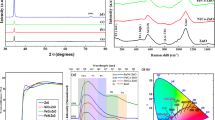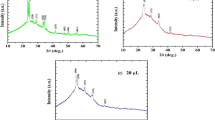Abstract
The effect of in situ addition of potassium permanganate (KMnO4) in controlling morphology, composition, structural and optical properties of the ZnO nanostructures prepared by hydrothermal technique has been investigated. The influence of synthesis conditions on the growth of ZnO nanorods was meticulously studied by field-emission scanning electron microscope, X-ray diffractometer, transmission electron microscopy (TEM) and high-resolution TEM. It is demonstrated that the KMnO4 concentration has great influence on the morphology and on the alignment of ZnO nanorods. Further the optical properties of nanostructures were investigated by photoluminescence (PL) spectroscopy and ultraviolet–visible diffuse reflectance spectroscopy. The PL spectrum divulged a continuous suppression of defect-related broadband emission by increasing the concentration of the KMnO4, which produced the quenching of surface defects present in the nanorods. The intensity ratio of the peaks corresponding to near-band emission (NBE) to that of deep-level emission of the KMnO4-modified ZnO nanorods was found to increase by eightfold of magnitude. Further it must be noted that nearly 17-fold enhancement in the PL emission of the peak corresponding to NBE was observed in KMnO4-modified ZnO compared to the ZnO grown without any additive. The I–V plot showed dependence of current values under dark and illumination over the amount of KMnO4 added during the growth stage.
Graphical Abstract








Similar content being viewed by others
References
Ozgun U, Alivov YI, Liu C, Teke A, Reshchikov MA, Dogan S, Avrutin V, Cho SJ, Morkoc H (2005) A comprehensive review of ZnO materials and devices. J Appl Phys 98:**041301
Huang MH, Mao S, Feick H, Yan H, Yu Y, Kind H, Weber E, Russo R, Yang P (2001) Room-temperature ultraviolet nanowire nanolasers. Science 229:1897–1899
Bao J, Zimmler MA, Capasso F, Wang X, Ren ZF (2006) Broadband ZnO single-nanowire light-emitting diode. Nano Lett 618:1719–1722
Shen Q, Ogomi Y, Das SK, Pandey SS, Yoshino K, Katayama K, Momose H, Toyoda T, Hayase S (2013) Huge suppression of charge recombination in P3HT–ZnO organic–inorganic hybrid solar cellsby locating dyes at the ZnO/P3HT interfaces. Phys Chem Chem Phys 15:14370–14376
Law M, Greene LE, Johnson JC, Saykally R, Yang P (2005) Nanowire dye-sensitized solar cells. Nat Mater 4:455–459
Debashis P, Tseung YT (2013) One-dimensional ZnO nanostructures: fabrication, optoelectronic properties, and device applications. J Mater Sci 48:6849–6877
Tin YZ, Wang JP, Sun BQ, Blakesley JC, Greenhan NG (2008) Solution-processed ultraviolet photodetectors based on colloidal ZnO nanoparticles. Nano Lett 8:1649–1653
Liang H, Gordon RG (2007) Atmospheric pressure chemical vapour deposition of transparent conducting films of fluorine doped zinc oxide and their application to amorphous silicon solar cells. J Mater Sci 42:6388–6399
Palani IA, Nakamura D, Okazaki K, Higashihata M, Okada T (2011) Influence of Sb as a catalyst in the growth of ZnO nano wires and nano sheets using nanoparticle assisted pulsed laser deposition (NAPLD). Mater Sci Eng B 176:1526–1530
Tian ZR, Voigt JA, Liu J, Mckenzie B, Mcdermott MJ, Rodriguez MA, Konishi H, Xu H (2003) Complex and oriented ZnO nanostructures. Nat Mater 2:821–826
Vayssieres L, Keis K, Lindquist SE, Hagfeldt A (2001) A purpose-built anisotropic metal oxide material: 3D highly oriented microrod array of ZnO. J Phys Chem B 105:3350–3352
Gomez JL, Tigli O (2013) Zinc oxide nanostructures: from growth to application. J Mater Sci 48:612–624
Dixit T, Palani IA, Singh V (2015) Investigation on the Influence of dichromate Ion on the ZnO Nano-dumbbells and ZnCr2O4 Nano-walls. J Mater Sci: Mater Electron 26:821–829
Bilgaiyan A, Dixit T, Palani IA, Singh V (2015) Improved Photo Response of Hybrid ZnO/P3HT Bilayered Photo Detector Obtained Through Oriented Growth of ZnO Nanorod Arrays and the Use of Hole Injection Layer. J Elect Mater. doi:10.1007/s11664-015-3712-x) (article in press)
Qiu D, Yu P, Jiang Y, Wu H (2006) Fabrication of ZnO nanoneedle/nanocolumn composite films and annealing induced improvement in their microstructural and photoluminescence characteristics. J Mater Sci Technol 22:541
Park KS, Choi YJ, Ahn MW, Kim DW, Sung YM, Park JG, Choi KJ (2009) Enhancement of field-emission properties in ZnO nanowire array by post-annealing in H2 ambient. J Nanosci Nanotechnol 9:4328–4332
Dev A, Niepelt R, Richters JP, Ronning C, Voss T (2010) Stable enhancement of near-band-edge emission of ZnO nanowires by hydrogen incorporation. Nanotechnology 21:065709
Stoehr M, Juillaguet S, Kyaw TM, Wen JG (2005) Optical properties of Ga2O3 doped ZnO nanoribbons. Phys Status Solidi C 2:1314
Guo M, Diao P, Caib S (2005) Hydrothermal growth of well-aligned ZnO nanorod arrays: dependence of morphology and alignment orderingupon preparingconditions. J Solid State Chem 178:1864–1873
Ma T, Guo M, Zhang M, Zhang Y, Wang X (2007) Density-controlled hydrothermal growth of well-aligned ZnO nanorod arrays. Nanotechnology 18:035605
Palod PA, Singh V (2015) Facile synthesis of high density polypyrrole nanofiber network with controllable diameters by one step template free electropolymerization for biosensing applications. Sen Actuators B 209:85–93
Dem’yanets LN, Kostomarov DV, Kuz’mina IP (2002) Chemistry and kinetics of ZnO growth from alkaline hydrothermal solutions. Inorg Mater 38:124–131
Ikono R, Akwalia PR, Siswanto Wahyu WB, Sukarto A, Rochman NT (2012) Effect of pH variation on particle size and purity of nano zinc oxide synthesized by Sol–Gel Method. Int J Engl Technol 12:5–9
Baruah S, Dutta J (2009) pH-dependent growth of zinc oxide nanorods. J Cryst Growth 311:2549–2554
Tang Q, Zhou W, Shen J, Zhang W, Kongb L, Qian Y (2004) A template-free aqueous route to ZnO nanorod arrays with high optical property. Chem Commun 6:712–713
Piquemal JY, Briotb E, Brégeaultc JM (2013) Preparation of materials in the presence of hydrogen peroxide: from discrete or zero-dimensional objects to bulk materials. Dalton Trans 42:29–45
Lee JD (2008) Concise inorganic chemistry, 5th edn. Oxford University Press, Oxford, pp 734–752
Smith MB, March J (2007) March’s advanced organic chemistry, 6th edn. Wiley-Interscience, New York
Yamabi S, Imai H (2002) Growth conditions for wurtzite zinc oxide films in aqueous solutions. J Mater Chem 12:3773–3778
Kokotov M, Hodes G (2009) Reliable chemical bath deposition of ZnO films with controllable morphology from ethanolamine-based solutions using KMnO4 substrate activation. J Mater Chem 19:3847–3854
Djurišić AB, Leung YH (2006) Optical Properties of ZnO Nanostructures. Small 6:944–961
Djurišić AB, Ng AMC, Chen XY (2010) ZnO nanostructures for optoelectronics: material properties and device applications. Prog Quantum Electron 34:191–259
Naeem M, Hasanain SK (2012) Role of donor defects in stabilizing room temperature ferromagnetism in (Mn, Co) co-doped ZnO nanoparticles. J Phys Condens Matter 24:245305
Shalish I, Temkin H, Narayanamurti V (2004) Size-dependent surface luminescence in ZnO nanowires. Phys Rev B 69:245401
Lin KF, Cheng HM, Hsu HC, Lin LJ, Hsieh WF (2005) Band gap variation of size-controlled ZnO quantum dots synthesized by sol–gel method. Chem Phys Lett 409:208–211
Wei B, Zheng K, Ji Y, Zhang Y, Zhang Z, Han X (2012) Size-dependent bandgap modulation of ZnO nanowires by tensile strain. Nano Lett 12:4595–4599
Hassan NK, Hashim MR (2013) Flake-like ZnO nanostructures density for improved absorption using electrochemical deposition in UV detection. J Alloys and Compd 577:491–497
Su YK, Peng SM, Ji LW, Wu CZ, Cheng WB, Liu CH (2009) Ultraviolet ZnO nanorod photosensors. Langmuir 26:603–606
Soci C, Zhang A, Xiang B, Dayeh SA, Aplin DPR, Park J, Bao XY, Lo YH, Wang D (2007) ZnO Nanowire UV photodetectors with high internal gain. Nano Lett 7:1003–1009
Acknowledgments
One of the authors T. D. is grateful to FESEM, XRD, and PL facilities equipped at the Sophisticated Instrument Centre, IIT Indore.T. D. would further like to thank the Ministry of Human Resource and Development (MHRD), India, for providing the Teaching Assistantship (TA). Authors V. S. and I. A. P. would like to thank Director of IIT Indore for providing constant support and appreciation. The authors also acknowledge DST:JSPS S&T cooperation project (DST/INT/JSPS/P-176/2014) for supporting the travel to Kyushu University. Authors would further like to acknowledge Dr. Pankaj R Sagdeo for allowing the usage of UV Visible DRS facility.
Author information
Authors and Affiliations
Corresponding author
Rights and permissions
About this article
Cite this article
Dixit, T., Bilgaiyan, A., Palani, I.A. et al. Influence of potassium permanganate on the anisotropic growth and enhanced UV emission of ZnO nanostructures using hydrothermal process for optoelectronic applications. J Sol-Gel Sci Technol 75, 693–702 (2015). https://doi.org/10.1007/s10971-015-3741-1
Received:
Accepted:
Published:
Issue Date:
DOI: https://doi.org/10.1007/s10971-015-3741-1




